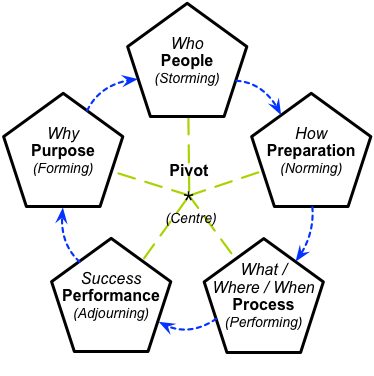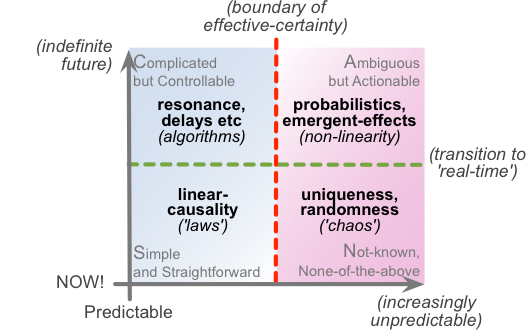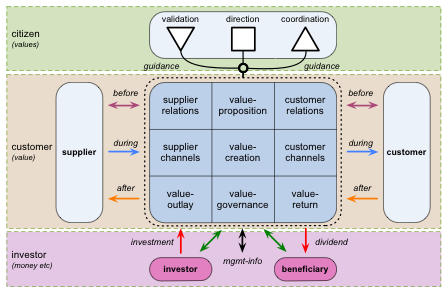Against fragmentation
If we’re trying to make sense of systems, our greatest enemy is fragmentation.
Or, to be more precise, the type of fragmentation that arises from misuse of analysis.
Specialise, says analysis. Specialise again! And specialise the specialisms! Hyperspecialise!
Cut it into pieces! Smaller and smaller pieces! Smaller! Smaller! Smaller!
And then wonder why the sense of the whole – and the elements that held it together as a whole – have somehow been lost in the process…
Especially when it’s so easy for so many of the fragmented pieces to have themselves become lost as well…
That’s the state of most of our organisations: split up into silos, fragmented again and again by hierarchies, fiefdoms and misplaced hope and hype, connections broken, pieces missing, endlessly dotting the joins. And a myriad of tools that each work well with only one type of content, one type of context, one specialism, one silo – and all of them in their well-meant way further contributing to the chaos, every darn step of the way.
Not A Good Idea…?
So what can we do about it? In my case, it’s been about building tools that do acknowledge the whole-as-whole – tools that work the same way with every type of content, in every context, in every scope, at every scale, every level, every step of implementation. Tools that are designed to support analysis, yes, but also to help link things together again, into that unified whole.
Tools such as Five Elements, as a method for guiding change:
Tools such as SCAN, to help make sense of uncertainty:
Tools such as Enterprise Canvas, a consistent way to describe the world – or any aspect of it – in terms of services and service-relationships:
For the past year, I’ve been working on a major rewrite of all of those tools, to make them more accessible to a general audience. It’s at the point now where we’re getting ready to go to market with them – with a chance to make a real difference in the way people work with change.
But there’s a catch – because that same darn fragmentation rears its ugly head again. Except this time it’s in the form of marketing.
There’s definitely a ‘unique selling point’ that connects all of the tools in the suite. The trick is that we take the usual assumptions about how tools work, and turn them on their head. Most existing tools start with the content, or the context, or both, and then bring a method to bear on that predefined content or whatever. What we do is that we start with a predefined type of question – for example, for SCAN, “How do we make sense of complexity in any given context?” – and then, when we hit up against that kind of question in a context, apply the related method, bringing to the method the respective content, content and more. And we can plug in any other existing method into that platform, as long as we can tweak them to work the same kind of way – linked to question first, then context and content. Which means that all of those methods then can and do work the same way with every type of content, context and more.
The key point about all of these tools in the suite – the one ‘non-negotiable’ – is that they apply the same way to everything, for everywhere, for everyone. The whole aim is to connect, everything, everywhere, everyone.
But the first thing that every marketer says is that we can’t do that: instead, they say, we must split our market into segments. One tool, one market-segment. A different tool for each market segment. A different description of each tool for each market segment, they say. Keep everything distinct, everything separate. Divide and rule.
Which, since our whole aim is to connect things together, is exactly what we don’t want to do. That in fact, by definition, we should not do.
Yet they won’t shift. Can’t sell the same thing to everyone, they say. Doesn’t work like that. No-one would believe you.
In other words, what they’re telling us is that to sell the idea, we must first betray the idea. Betray everything it stands for. And then build a marketing-campaign upon that betrayal.
Which ain’t gonna work…
Not for me, at any rate.
So what do I about this? What can I do about this?
Right now, I don’t know.
Yes, there is a sort of ‘market-segment’: the tools would be useful only to those people who are facing some kind of change. That’s a point where some kind of ‘market-positioning’ might be made. Even though, by definition, it’ll still ultimately be everyone, there’s a sort-of ‘segment’ there.
And there’s that distinct ‘unique selling-proposition’ – that this is, at last, a ‘platform-approach’ to tools-for-change, that really can work the same way, everywhere, for everyone.
But how do we ‘sell’ that, without falling into the same fragmentation-mistake that these tools are designed to prevent?
I don’t know any more. I’m out of my league here, out of my depth: if there’s one field I definitely don’t know, it’s marketing.
I’m stuck.
So if you have any ideas or suggestions on this, please let me know?





Have you considered creating use cases around an industry or situation that drives the conversations? Since breaking this down to targeted segments is not effective, then you may be able to identify Who should be using the tools, What benefits them and their organization, and finally Why use your tools to drive change.
Most capabilities and tools are able to be used on a broad array of opportunities, but it requires situational awareness to drive the choice and the ultimate message.
Thanks, Bryan. The Who is fairly straightforward, namely pretty much anyone who’s trying to tackle pretty much any kind of change. Which is a lot of people. The What is straightforward enough, too: it’s about ways to get to more effective change – rather than change that goes round in circles, change that does nothing useful, change that wastes a lot of effort for no advantage, or change that just makes things worse for everyone (all of which are depressingly common). Which then brings us to the Why combined with a bit of the How, which is that tools that take mitigate against fragmentation and adapt to the context are more likely to be more effective than those much more common tools that take a ‘solutioneering’-approach and try to force the context to fit the predetermined assumptions (which are often just plain wrong).
On situational-awareness: well, yes, that’s exactly what these methods are intended to elicit – almost like trick people into developing situational-awareness, as a ‘hidden’ precondition for the work itself.
Use-cases: yep, that’s the hard part. There are plenty of those on this blog – for example, ‘Using SCORE to reframe the business-model‘. The catch is that people don’t seem to notice them much, or attack the theory rather than observing the practice. Oh well.
Hi Tom,
I’m not a marketing expert either, yet I have worked with enough organizations as an industry analyst to have some ideas that may help. When a vendor tells me that their market is “everybody”, I tell them that even when it is true, it is not a helpful mindset. You can’t talk to “everybody”, only individuals with a unique perspective. Furthermore, you can’t go from zero to “supplier of everything” in most cases as there is too much risk from the customer’s perspective.
I typically recommend to them to start with identifying the most significant pain point where your solution is unquestionably better than all alternatives for a specific need. Sell that to customers, solve that problem well, then ask them, “Is there anything else you are struggling with that I may be able to help you improve?”
This is NOT the same as splitting your product and selling bits to different stakeholders. It is instead selling a digestible starting point as an entry to the organization.
Hopefully this makes sense – if not, let me know and we will refine until we figure it out.
My suggestion is
Hi Tom!
Very excited to be spending some time with you next week. Just wanted to follow on to Roger’s astute comment about digestible starting points, and say that for certain audiences, you have been doing just that with your videos (kudos!).
Instead of purely thinking in terms of marketing, perhaps it is helpful to consider what sort of “digestion support services” respective prospects may need to gain access to the capabilities on offer.
Additionally, if the ultimate goal is a broader culture shift towards integrative shared responsibility for architectural concerns across enterprises, identifying the scope of organizational commitment to advancing this goal may be necessary to better frame approaches to market strategy which may be useful. Looking forward to exploring this further with you next week!
Best,
Nate
http://www.normative.com
http://www.thinkfreshgroup.com
Try focussing marketing not on industry but on organizations and specifically people that adopt systems thinking?
Thanks, Roeland – in essence, that’s what I’m trying to do. As a metaphor, the situation feels increasingly like we’re aiming to sell screwdrivers that would be really useful to anyone who needs to put in screws, and being told that we should market only to dentists because someone once heard that dentists sometimes hold teeth in with screws. It really does feel as mad as that. Oh well…